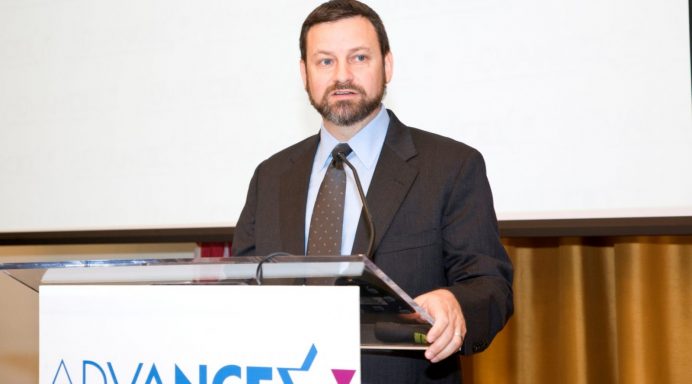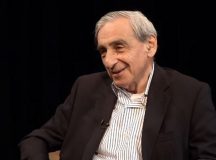Jay Ruderman is the President of the Ruderman Family Foundation, which focuses on the inclusion of people with disabilities worldwide and educating Israeli leaders on the American Jewish community. In this reflective essay he focuses on the roots of current tensions in the Israel-Diaspora relationship and suggests a plan to ease those tensions: ensure communal organisations include and represent the whole community they claim to speak for, in order to reconnect young diaspora Jews to Jewish institutions and organised communal life.
Israel is the country of its citizens, Jews and non-Jews alike. At the same time, Israel is the only Jewish country in the world, and – for better and for worse – represents Jews who do not hold an Israeli passport. Sometimes these overlapping roles create tensions. As the Jewish world looks at current tensions between Israel and the American Jewish community, all Jewish leaders – in the UK, France, Argentina and Australia, as well as the leaders of Israel and US Jewry – must understand they too are affected.
The Israel-diaspora relationship in the state’s early years
At Israel’s establishment in 1948, there were 600,000 Jews in Israel; by 1952, a mere four years later, some 700,000 additional Jews had arrived, mostly from Middle Eastern countries and the destroyed communities of the Holocaust. However, Aliyah was not the only way to support the young Jewish state. Jewish World War II veterans from English-speaking countries volunteered to fight for Israel and were the backbone of its primitive air force and navy. Donations for building hospitals, universities and absorption centres were flowing in rapidly. Civil engineers and construction experts helped to build the roads and infrastructure.
During the 1950s, a significant percentage of Israel’s national budget came from the American Jewish community, through direct donations and long-term loans issued by the Israel Bonds. Levi Eshkol, who was finance minister at the time, said the country ‘would not go bankrupt so long as we can beg’.
In these early years, Israelis viewed the American Jewish community (and others) as sources of economic support and donations. Jews outside of Israel, for their part, were happy to play the role and provide patronage. If you could not physically fight for Israel’s survival, you could at least help those who were doing so.
Changing Dynamics, New Frictions
However, as Israel grew stronger, the need for Jewish donations shrunk substantially. Israel’s economy today is strong and independent; the government budget is no longer based on donations from Diaspora Jewry. This change influenced Israel’s relationship with global Jewry. The one-way street of the early years, in which it was very clear who was supporting whom, was over. Current frictions between Israel and the American Jewish community can be traced to this shift in the power dynamics between the sides.
A number of recent research papers[1] highlight three major areas of friction between Israel and the American Jewish community. First, questions regarding religion and the state within Israel. Second, political disagreements over the Israeli-Arab conflict. And third, there is a growing values gap between Israel and the younger generation, as Israelis move more to the Right, while their American Jewish counterparts move to the socially liberal Left.
Religion and State within Israel
Questions regarding the relationship of religion and state have become a focal point for some of the sharpest clashes between Israel and organised American Jewry during recent years. While Israel recognises Orthodox Judaism as the only form of Jewish practice – according to Israeli law, Jewish weddings are Orthodox; the state subsidises Orthodox synagogues, and Orthodox groups manage funeral and burial ceremonies – only 10 per cent of American Jews are Orthodox. The vast majority are either completely unaffiliated, or associated with Reform, Conservative or other streams of Judaism.
Argument over the status within Israel of non-Orthodox streams of Judaism erupted in the summer of 2017, when the Israeli government reneged on the Western Wall agreement which would have given the non-Orthodox denominations greater access and a say in the management of the holy site. Additionally, it decided to advance a new Conversion law. Both moves caused an uproar among the leadership of the American Jewish community. For many non-Orthodox Jews, the question of prayer at the Kotel spoke to the key question: ,would the Jewish state allow Jews to practice their Judaism in Israel?
Political Differences
American Jews are overwhelmingly liberal. Some 70 per cent of Jewish voters have voted for the Democratic candidate in every Presidential election since 1992. On the other hand, Israelis have elected right-wing governments for nearly 20 years. An 18-year-old Jew entering university today has no personal recollection of a left-wing Israeli government, the last of which ended in 2001. President Donald Trump’s election in 2016 emphasised this political divide more than ever before. As someone put it: Israelis love Trump because of his foreign policy, while American Jews despise him because of his domestic policy.
Moreover, with Benjamin Netanyahu in office since 2009, many young Jews can no longer separate Israel from a specific kind of Israeli government. His embrace of Trump signals to them that Israel is a one-dimensional country, representing the politics and people they wish to remove from the White House.
The inter-generational challenge
While older Jews in the Diaspora remember Israel as a young, fragile country fighting for its survival, the young cannot remember a world without a Jewish state and a Jewish army. They do not remember the pre-1967 days when war meant the potential destruction of the Jewish state. They don’t even remember the horrific terror attacks of the 1990s.
The mirror image is true for Israelis. The second, third and fourth generations have no personal recollection of life in a Diaspora community. The stories of their grandparents who came by boat from Hungary or by plane from Iraq are tales from history.
The result is that while Israelis no longer see themselves as a minority, Diaspora communities do. And with antisemitism rising, they increasingly feel they need defending as such. As a result, they look on with alarm at Israel’s warming relations with global leaders who seem to combine pro-Israelism with a seeming willingness to indulge dog-whistle antisemitism.
In short, with Israel no longer needing the financial donations of Diaspora Jews to survive, and with Diaspora Jewry allowing itself to challenge Israeli policy more than ever before, the relationship between Israel and Diaspora Jewry has fundamentally shifted. And in recent years, things have only worsened. American Jews saw Israel’s new Conversion bill and its cancellation of the Western Wall compromise as a clear message that the Jewish state no longer cares about the position or opinion of non-citizen Jews. Israelis, by contrast, saw the rise in Diaspora Jewish participation in political campaigns against Israeli policy, including in some cases support for the BDS (Boycott, Divestment and Sanctions) Movement, as an equally clear message that Jews were no longer committed to Israel’s wellbeing.
Of course, neither message was said explicitly, but today’s online world does not allow for complexity or nuance. The Twitter-sphere reduces ‘conversation’ to 280 characters. Social media forces everyone to boil down their opinions into click bait and one-liners. The American Jewish community may yet find themselves heading towards a disastrous collision.
Making American Jewish Communal organisations more representative
As of 2019, the Jews living in Israel and the US account for some 85 per cent of all Jews. In a certain sense, both view themselves as representing Judaism and the Jewish People. So troubles between the two are sure to affect other Jewish communities around the world. It is now vital to find ways to reduce the tensions, not least because trends that start in Jewish America arrive at Jewish communities in other countries a few years later. Look for instance at data regarding participation of Jewish children in Jewish day schools, Jews marrying non-Jews or literacy in the Hebrew language. These challenges were once unique to American Jewry, but today are relevant for Jewish communities all over the world. Global Jewry can help reduce tensions in the Israel-US relationship, acting as a fair mediator between the sides.
For Jewish leaders in the Diaspora, it is easy to point fingers at Israel, and to some extent this would be justified. But we should also look at ourselves and ask how we can bring a positive change.
Some people claim the tensions between the American Jewish community and Israel are the result of diaspora Jews disengaging from Judaism. If Jews connect more to their Judaism, they say, they will also connect more to Israel. Without completely disregarding this notion, we must remember there are many Jews who received the best Jewish education but who are still at odds with Israel. Perhaps young Jews are not disconnecting from Judaism as such but rather from Jewish institutions and organised communal life?
There is a lack of diversity and representation at the organisational level. This causes younger Jews to disengage from the institutions meant to represent them. This disengagement is not only from the institutions – but also from traditional communal life. Since the community’s ties with Israel run first and foremost through its institutions – federations, educational groups and others – stepping away from the organised Jewish world is also a step away from established connections to Israel.
It is possible, I think, that the chasm between the Jewish community and the groups representing it is as large – if not larger – than that between Diaspora Jews and Israel.
Using the American Jewish community as a case study, I would like to propose a plan relevant to all Jewish communities. The heart of the plan is simple to state but harder to execute: ensure communal organisations represent the community they claim to speak for. At a time when newly elected political figures in the US are looking more like the American people as a whole, nonprofits that advance Jewish causes are stuck in a cycle that ensures a small group of ultra-wealthy donors calls the shots. It is time Jewish organisations tackled the imbalance of power and the homogeneity of faces within their leadership circles.
America’s formal Jewish institutions – from umbrella bodies to local and national organisations to advocacy groups – serve the needs of Jews in the US, Israel and beyond. Yet, these once-strong advocates no longer reflect large segments of American Jewry, as their leadership is largely decided by the sum on the donation check.
This skew is nothing new. As early as the 1960s, activists were demanding that the leadership of federations extend beyond a handful of major philanthropists. Not much has changed. While there is a gender balance in these organisations’ governance bodies, representation of the broad diversity of the Jewish population is lacking. In the US, Jewish leadership is overwhelmingly composed of male, old, white Jews. On the other hand, there is a glaring lack of Middle Eastern Jews, Russian-speaking Jews, Jews with disabilities, Israeli-American Jews, Jews of colour, LGBTQ Jews, and millennial Jews.
The US Jewish world compares unfavourably with the country’s political institutions. In the 2018 midterms we saw Congress change greatly as more minorities and women took office. Female representation grew from 92 women in the 115th Congress to 106 in the 116th. Capitol Hill also became more racially diverse, with a 10 per cent rise in African-American representation, a nearly 15 per cent increase in Asian representation, and a 100 per cent increase in Native American representation. This Congress also saw record growth in the black and Hispanic caucuses. Further, there has been a generational shift. The numbers of Generation Xers (born mid 1960s-1980s) in Congress grew 17 per cent, and millennials (born 1980s-1990s) skyrocketed 420 per cent, while representation among the older Silent Generation and baby boomers decreased about 13 per cent. Overall, the average age in Congress fell from 57 to 47.
Unfortunately, Jewish nonprofits have not yet seen these changes in their leadership bodies. Only by moving away from an overreliance on ultra-wealthy donors and engaging more Jews through online fundraising and authentic representation, can the Jewish community elicit greater buy-in from a larger portion of the Jewish people.
Jewish donors have invested millions in programmes that combat assimilation and encourage young Jews to build stronger bonds to organisations that advance their faith. I believe greater responsiveness to the diversity of US Jewry, this securing greater participation in the organised Jewish life, would do more to ensure Jewish continuity than any donation ever could. Additionally, making Jewish Communal organisations more representative would be a critical step towards fostering the strategic relationship between the Jewish community and Israel. The tensions between Israel and the American Jewish community often stem from a lack of dialogue between the sides. Today, no organisation can truly speak on behalf of the Jewish community, and Israeli leaders can choose which organisation to elevate.
We need to find a way to reduce the tensions stemming from religious and political differences. While it is impossible to resolve these debates, it is possible to conduct them in a civil manner with respect for the person sitting opposite us. For this to happen, we need to build a framework for dialogue and debate, not just at times of crisis but also during our daily lives. In the diplomatic world, it is common for states to have government-to-government (G2G) forums in which the sides discuss matters. While there is no ‘Diaspora Government,’ better representation in communal organisations would allow for better dialogue with the Israeli government, not least by creating a platform for routine communications, as opposed to crisis-based talks.
More than two years removed from the crisis of the Western Wall, there is little discussion going on between the sides about what the next step should be. If the sides would talk on a regular basis, it would gradually reduce the various crises we have witnessed. So long as we only meet at troubling times, those are also the only topics our leadership – in Israel and among Jewish communities – will discuss.
There is no magic pill, and nothing is guaranteed. However, I am confident that greater democracy will lead to greater participation. And by making our leadership structures more inclusive, Jewish nonprofits can achieve both greater stability, connecting the younger generation to the community, as well as to Israel.
[1] See for instance: Assaf Orian and Shahar Eilam (Editors), The American Jewish Community and Israel’s National Security, The Institute for National Security Studies, Tel Aviv, 2018





































In 2004 at Oxford a major refit began of a Synagogue. Modern, accessible and inclusive.
It takes care of the needs of the Jewish.community. It covers the needs of Jews from aspects of Judaism. Unless, we unite, we can become divided by those who wish to divide. I believe as a disabled woman in inclusion, that’s inclusion with all forms of Judaism.